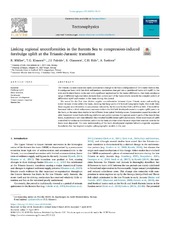| dc.contributor.author | Müller, Reidar | |
| dc.contributor.author | Klausen, Tore Grane | |
| dc.contributor.author | Faleide, Jan Inge | |
| dc.contributor.author | Olaussen, Snorre | |
| dc.contributor.author | Eide, Christian Haug | |
| dc.contributor.author | Suslova, Anna A. | |
| dc.contributor.author | Suslova, Elena N. | |
| dc.date.accessioned | 2020-08-12T09:20:23Z | |
| dc.date.available | 2020-08-12T09:20:23Z | |
| dc.date.issued | 2019 | |
| dc.Published | Müller R, Klausen TG, Faleide JI, Olaussen S, Eide CH, Suslova A. Linking regional unconformities in the Barents Sea to compression-induced forebulge uplift at the Triassic-Jurassic transition. Tectonophysics. 2019;765:35-51 | eng |
| dc.identifier.issn | 0040-1951 | en_US |
| dc.identifier.issn | 1879-3266 | en_US |
| dc.identifier.uri | https://hdl.handle.net/1956/23677 | |
| dc.description.abstract | The Triassic-Jurassic transition marks an important change in the basin configuration of the Greater Barents Sea. A contiguous basin with km-thick sedimentary successions changed into a partitioned basin with uplift in the west and foreland basins in the east with significant implication for the basin infill history. Our study employs a range of different high-resolution datasets from a distal part of the basin which unravels the complex pattern of differential uplift and erosion in the basin during this period. We record for the first time distinct angular unconformities between Upper Triassic strata and overlying Lower Jurassic strata within the basin, showing that large parts of it formed topographic highs. Our study links these angular unconformities to compression induced by the Novaya Zemlya Fold and Thrust Belt. A heterolithic basement below a thick sedimentary succession where the fold belt developed created a complex uplift pattern in the basin, at the same time similar to but different from typical forebulge areas. Compression caused inversion of older basement rooted faults defining platforms and graben systems throughout western parts of the Barents Sea basin, in addition to salt remobilization that resulted in differential uplift and erosion. These local zones of uplift controlled the sediment distribution pattern to the basin at a time when the most important reservoir units in the basin were deposited. This new understanding of the basin development explains hitherto enigmatic sequence boundaries that has inspired complex paleogeographic models in the past. | en_US |
| dc.language.iso | eng | eng |
| dc.publisher | Elsevier | en_US |
| dc.rights | Attribution CC BY | eng |
| dc.rights.uri | http://creativecommons.org/licenses/by/4.0 | eng |
| dc.title | Linking regional unconformities in the Barents Sea to compression-induced forebulge uplift at the Triassic-Jurassic transition | en_US |
| dc.type | Peer reviewed | |
| dc.type | Journal article | |
| dc.date.updated | 2019-11-26T19:02:48Z | |
| dc.description.version | publishedVersion | en_US |
| dc.rights.holder | Copyright 2019 The Author(s) | en_US |
| dc.identifier.doi | https://doi.org/10.1016/j.tecto.2019.04.006 | |
| dc.identifier.cristin | 1702413 | |
| dc.source.journal | Tectonophysics | |

